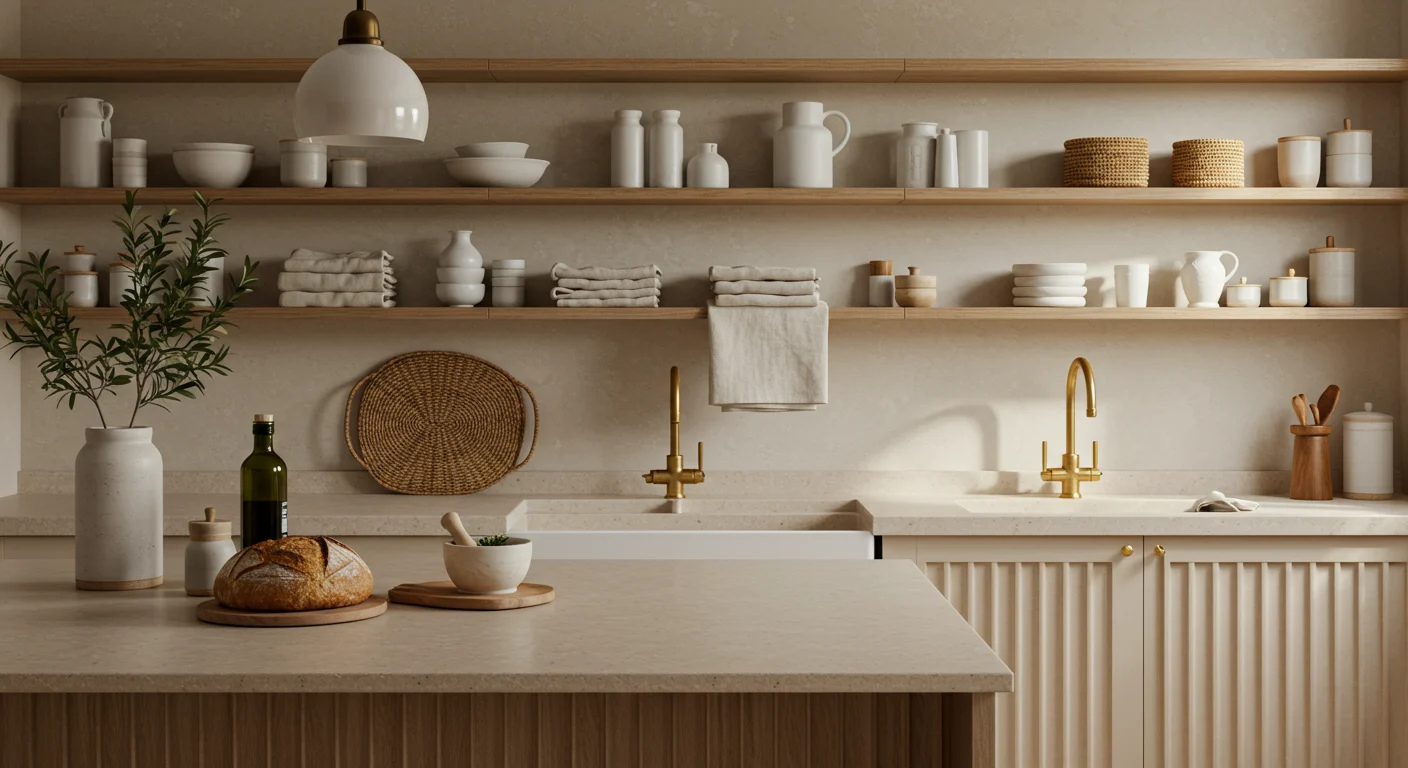So you love the idea of a warm, neutral kitchen but you’re worried about creating something that looks more like a beige box than the inviting, sophisticated space you actually want to cook in. You’ve probably seen those “neutral” kitchens that are just different shades of bland, or the ones that are so afraid of color they end up feeling cold and institutional instead of warm and welcoming.
Here’s what most people get wrong about warm neutral kitchens: they think neutral means boring or that warm means everything has to be the same shade of beige. But the best warm neutral kitchens layer different textures, materials, and subtle color variations to create spaces that feel both sophisticated and genuinely cozy—like expensive coffee shops where you actually want to spend time.
Whether you’re renovating from scratch or trying to add warmth to your current kitchen, these approaches will help you create a neutral space that feels intentional and luxurious rather than safe and forgettable.
Understanding What Makes Neutrals Actually Warm
Before diving into specific design approaches, let’s talk about what separates genuinely warm neutral kitchens from ones that just look beige and basic.
Undertones Matter More Than Base Colors – Warm neutrals have subtle undertones of cream, honey, or soft pink that make them feel cozy rather than institutional. Avoid anything that reads too gray or cold.
Texture Creates Richness – In neutral kitchens, texture becomes your main source of visual interest since you’re not relying on bold colors to create drama.
Natural Materials Add Authenticity – Real wood, actual stone, and quality metals separate luxurious neutral kitchens from basic builder-grade ones.
14 Warm Neutral Kitchen Styling Ideas
1. Create Drama With Bookmatched Calacatta Islands
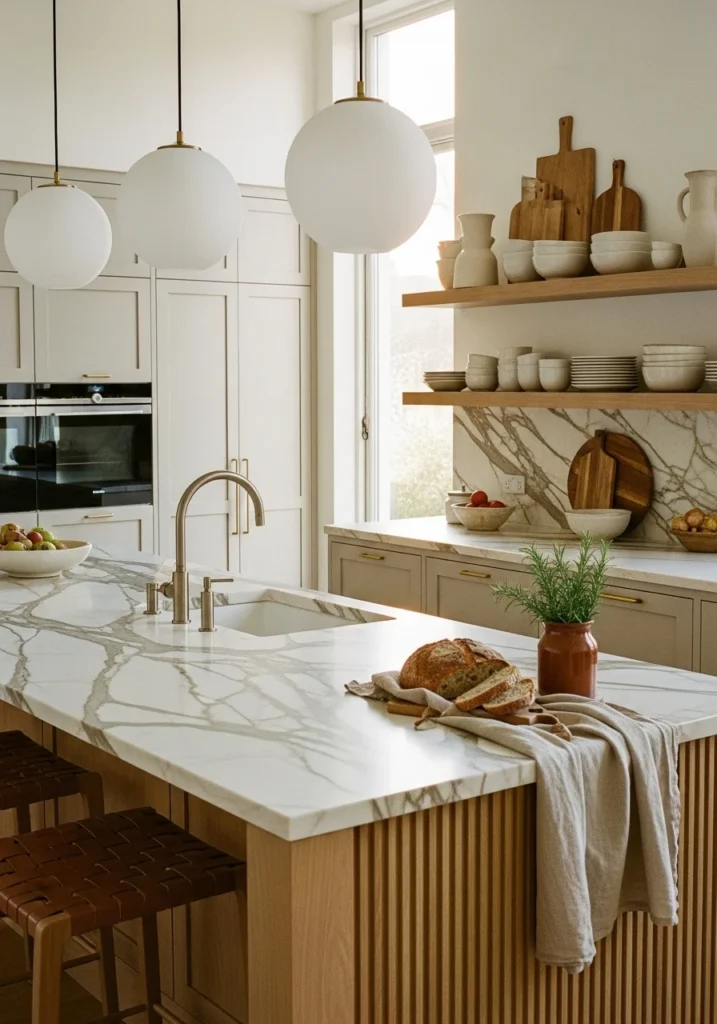
Center your kitchen around a bookmatched Calacatta waterfall island with warm beige veins and low-profile integrated sinks. Use soft greige matte cabinetry with fluted oak panels on island bases while hiding appliances behind matching panels.
Add satin brass faucets, woven leather counter stools, and floating oak shelves styled with cream ceramics. Use oversized frosted-glass pendants with warm 2700K lighting to create that perfect morning coffee atmosphere.
2. Soften Hard Lines With Curved Islands and Banquettes
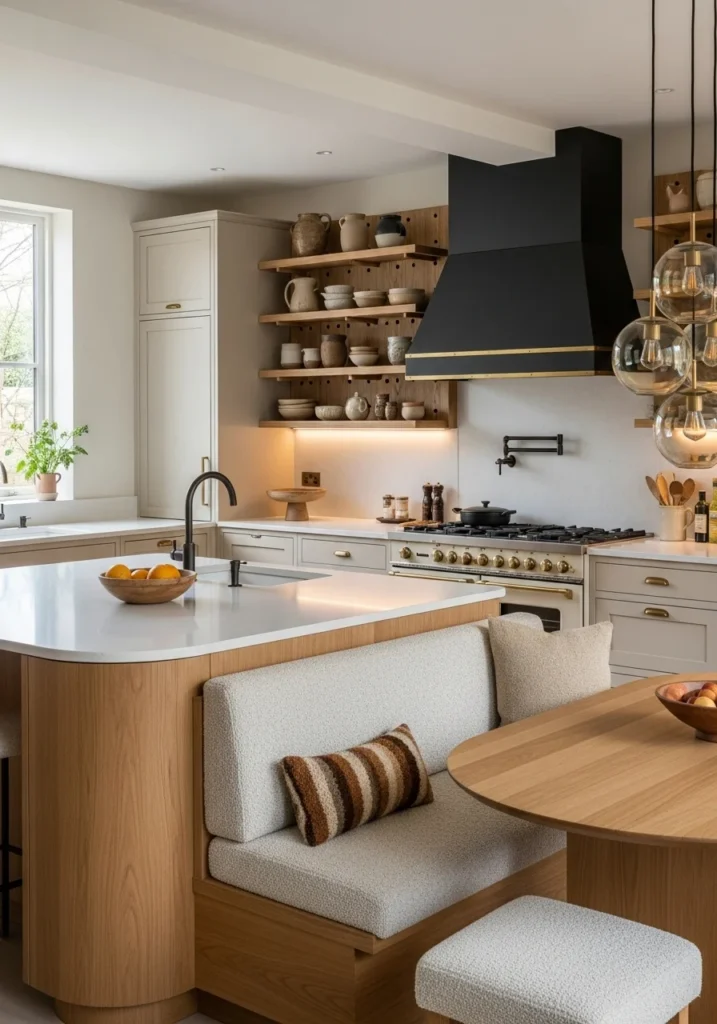
Design sculptural curved islands in warm sandstone quartz paired with integrated oak banquettes upholstered in soft boucle. Use warm oatmeal cabinetry with open peg-shelves displaying hand-thrown pottery.
Add matte black brass range hoods above cream professional ranges while pendant clusters of amber glass globes provide intimate lighting. The curves create flow and visual interest within the neutral palette.
3. Achieve Seamless Minimalism Through Handleless Design
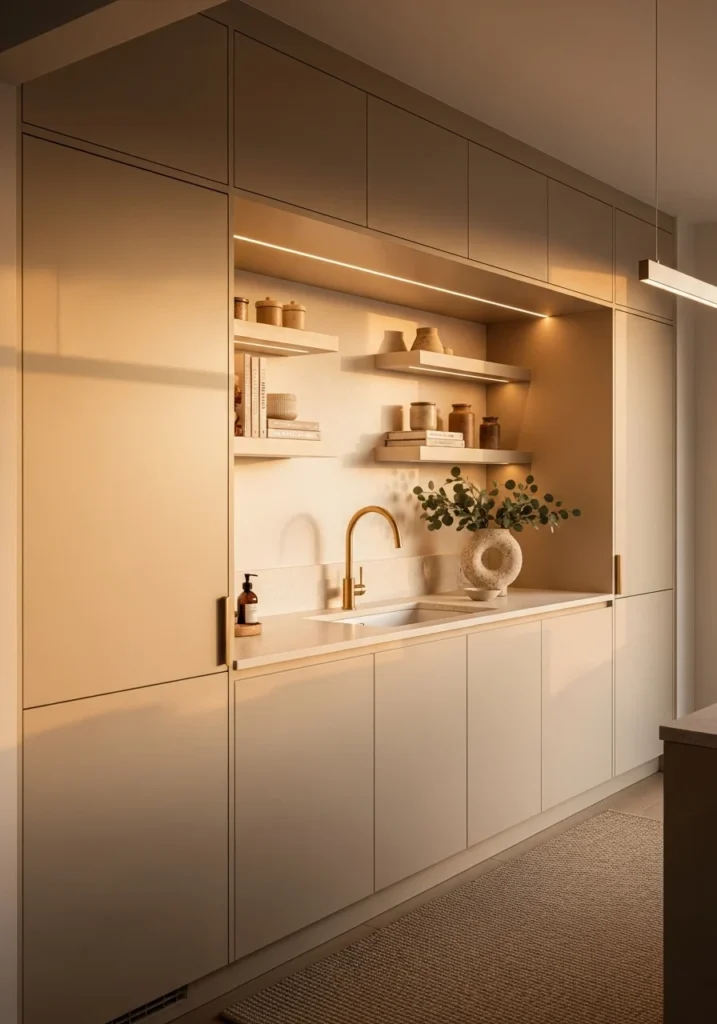
Create clean, modern looks using handleless matte sand lacquer cabinetry with thin honed limestone countertops and seamless full-height pantry walls. Use soft ivory plaster backsplashes with recessed floating shelves.
Style with brass single-handle faucets, sculptural vases with eucalyptus, and neutral jute runners. Concealed cove lighting and slim linear pendants maintain the uncluttered aesthetic while providing function.
4. Add Richness Through Two-Tone Material Combinations
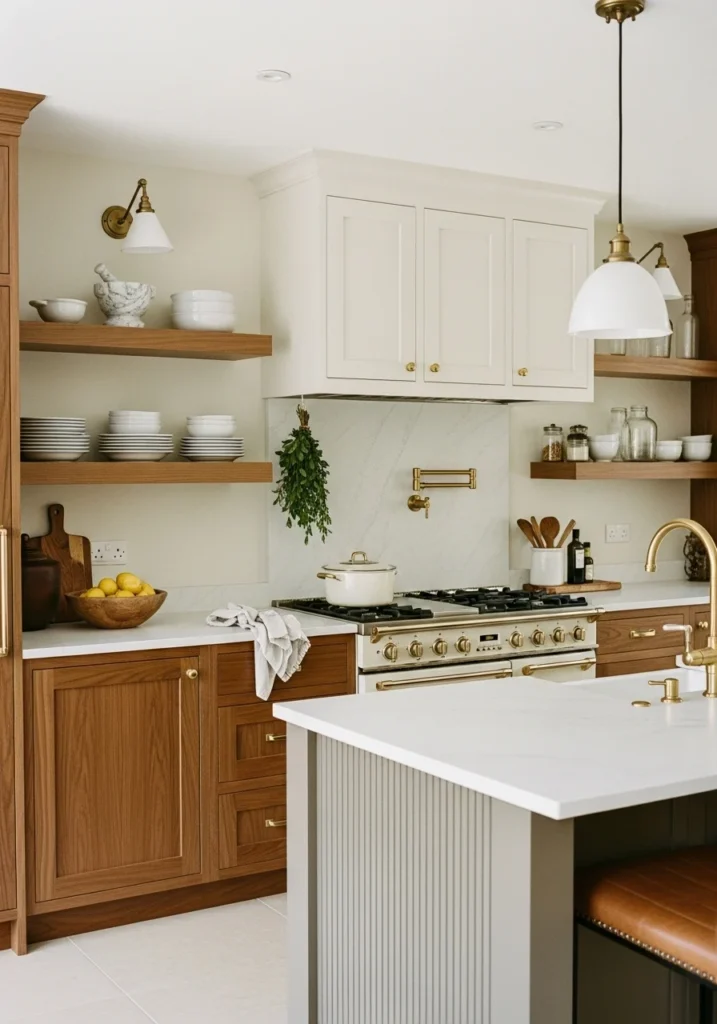
Pair warm walnut lower cabinets with alabaster painted uppers, honed alabaster countertops, and open oak shelving for visual layering. Include statement brass pot-fillers over cream enamel ranges with fluted island panels.
Use leather-topped bar stools and style with marble mortars, stacked white plates, and wooden bowls of fresh citrus. The material contrast creates sophistication within the neutral framework.
5. Blend Modern Lines With Rustic Timber Accents
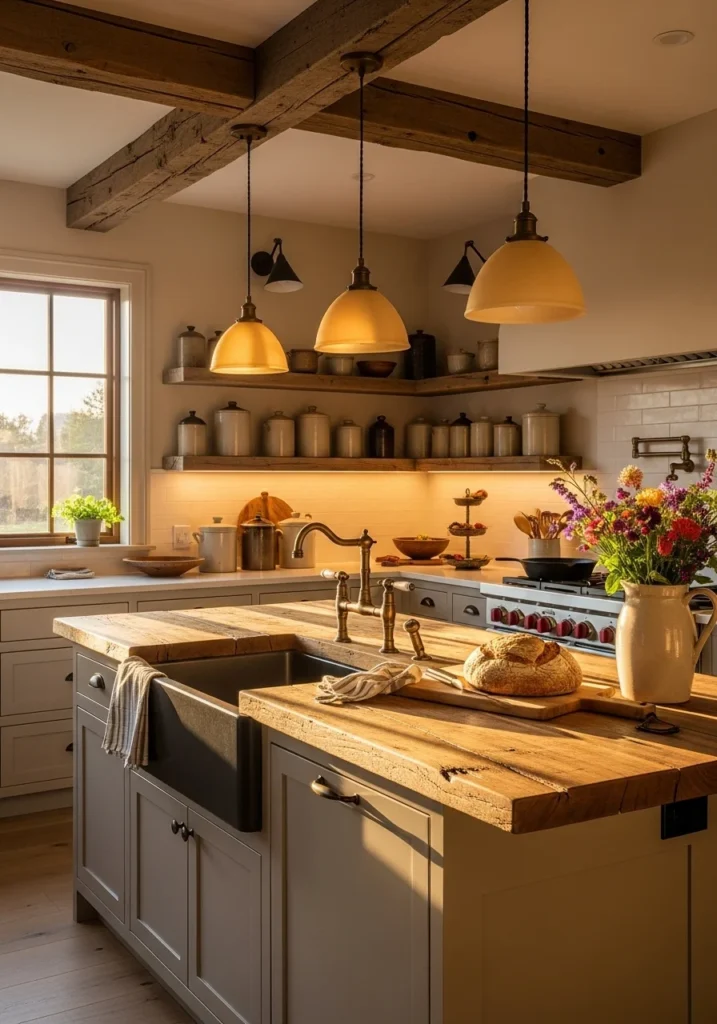
Combine clean modern cabinetry with reclaimed timber ceiling beams and wide reclaimed-wood island tops over neutral sand-colored bases. Use black matte apron sinks with aged brass fixtures for authentic character.
Style with cast-iron skillets, artisan breads on cutting boards, and ceramic pitchers of wildflowers. Amber pendant lamps and undercounter LEDs create cinematic late-afternoon warmth.
6. Add Textural Interest Through Glazed Terracotta
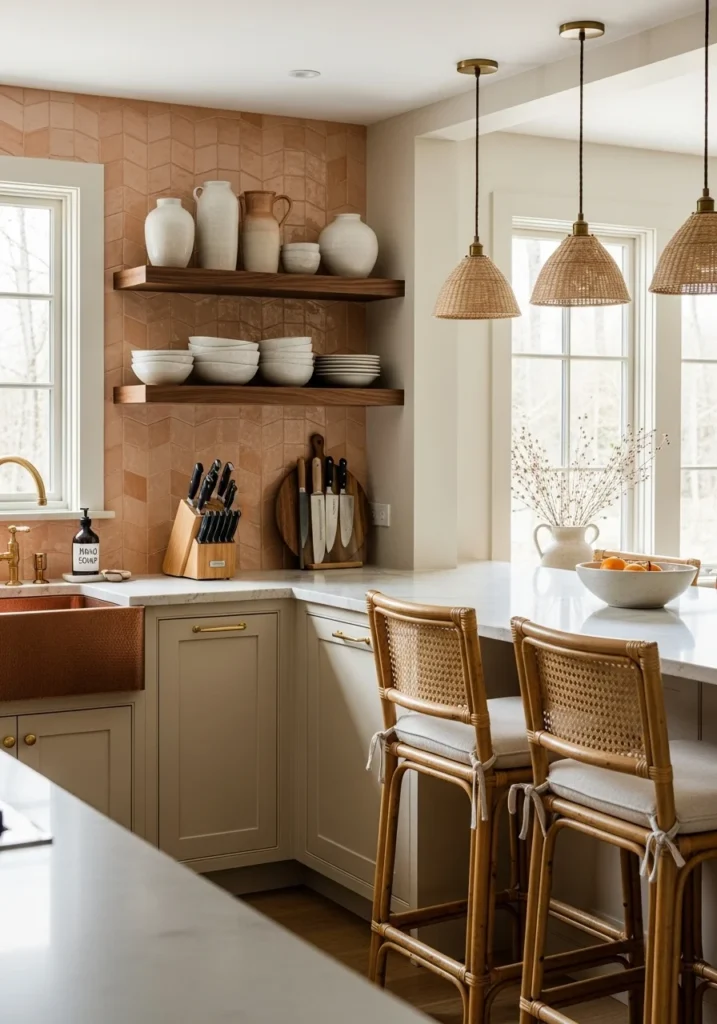
Showcase glossy terracotta tile backsplashes in soft apricot tones against warm cream cabinetry. Use honed limestone countertops with walnut floating shelves and copper farmhouse sinks with arched brass faucets.
Include rattan counter stools and style with wooden knife blocks and handmade pottery. Pendant lamps with woven shades complement the textural richness while maintaining the warm palette.
7. Create Service Areas With Integrated Butler Pantries
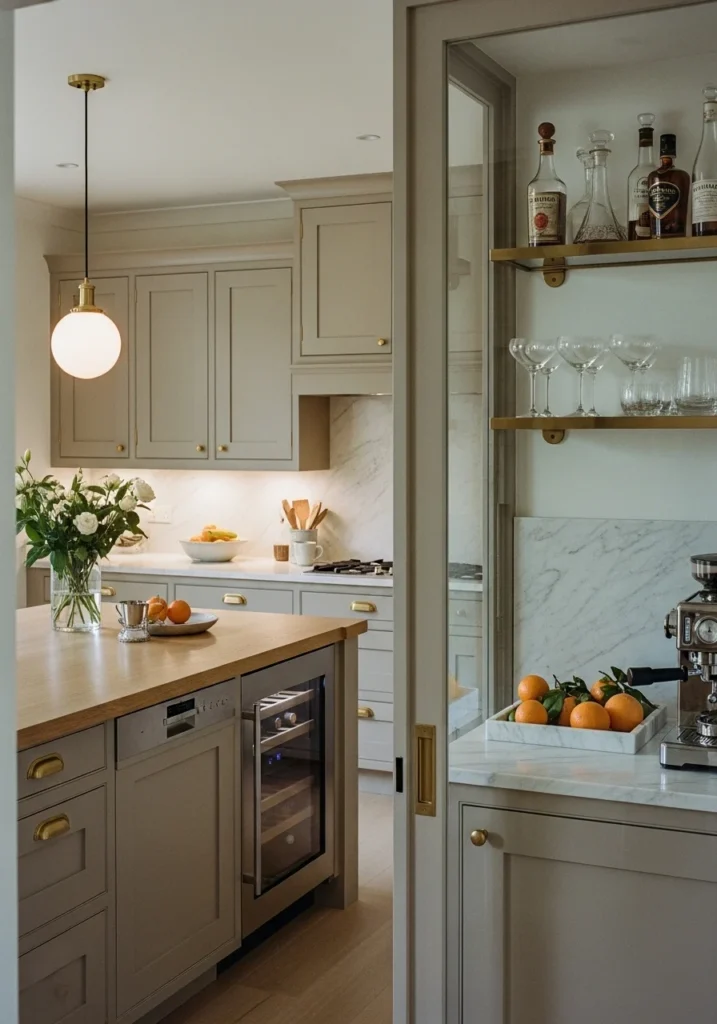
Design refined kitchens with soft taupe shaker cabinetry and glass-front butler pantries revealing marble counters and brass shelving. Use light oak islands with waterfall edges seamlessly.
Style with stacked glassware, espresso setups, and marble trays with fresh citrus. Under-cabinet task lighting and warm pendants create both function and atmosphere.
Also Read: 15 Luxury Bathroom Lighting Ideas That Make Your Morning Routine Feel Like a Spa Ritual
8. Ground Your Space With Herringbone Oak Flooring
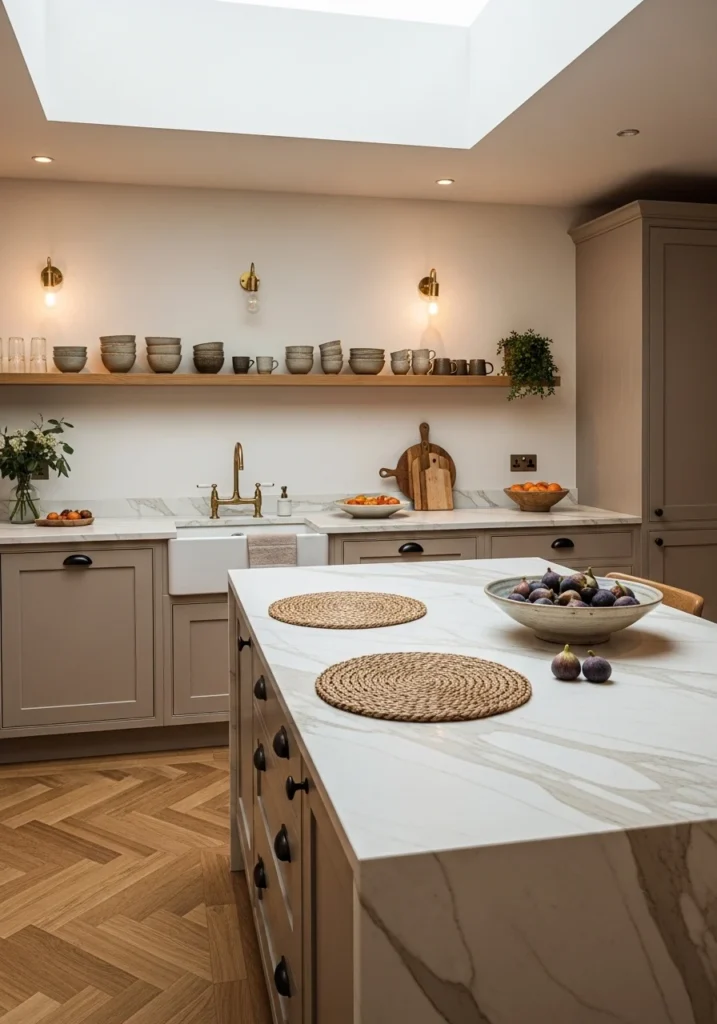
Use wide herringbone oak flooring as your foundation with central marble slab islands featuring soft beige veining. Choose warm latte-toned cabinets with black metal pulls while floating oak shelves display daily ceramics.
Add brass bridge faucets and style with hand-woven placemats and bowls of fresh figs. Skylights combined with warm recessed lighting create perfect editorial mood throughout the day.
9. Embrace Contemporary Materials Through Soft Terrazzo
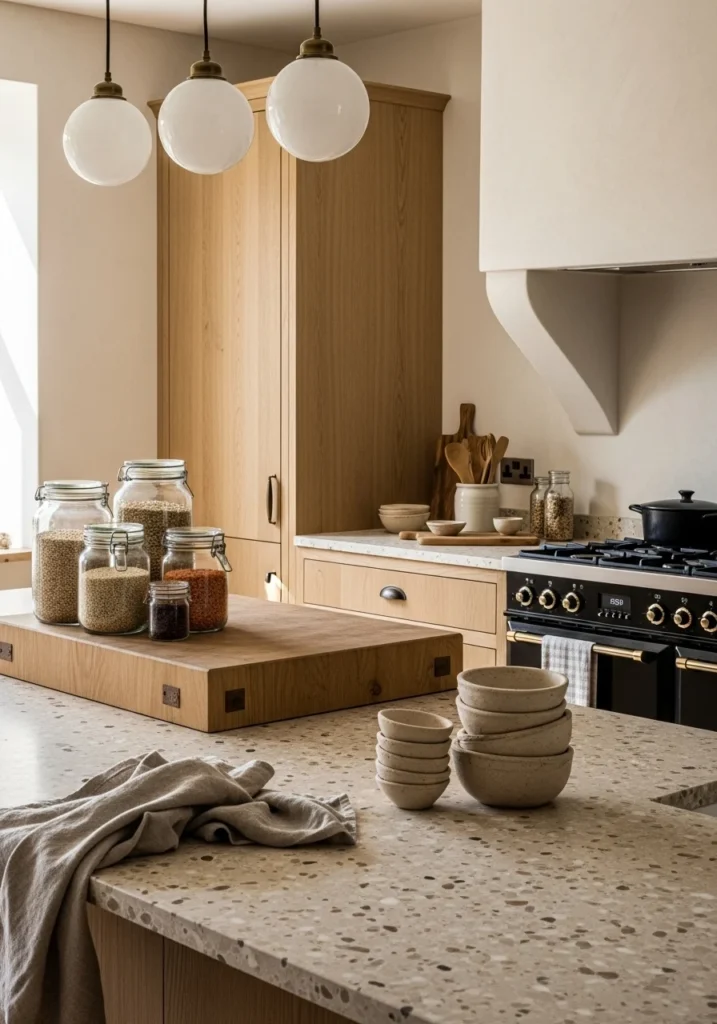
Use soft beige terrazzo countertops paired with warm stone-washed cabinetry for contemporary rustic appeal. Include raw oak butcher block prep stations with matte black ranges against textured plaster walls.
Style with glass grain jars, linen towels, and clay ramekins for artisanal character. Pendant clusters with opal glass create soft, diffused lighting that enhances the terrazzo’s subtle texture.
10. Create Cozy Gathering Spaces With Fireplace Nooks
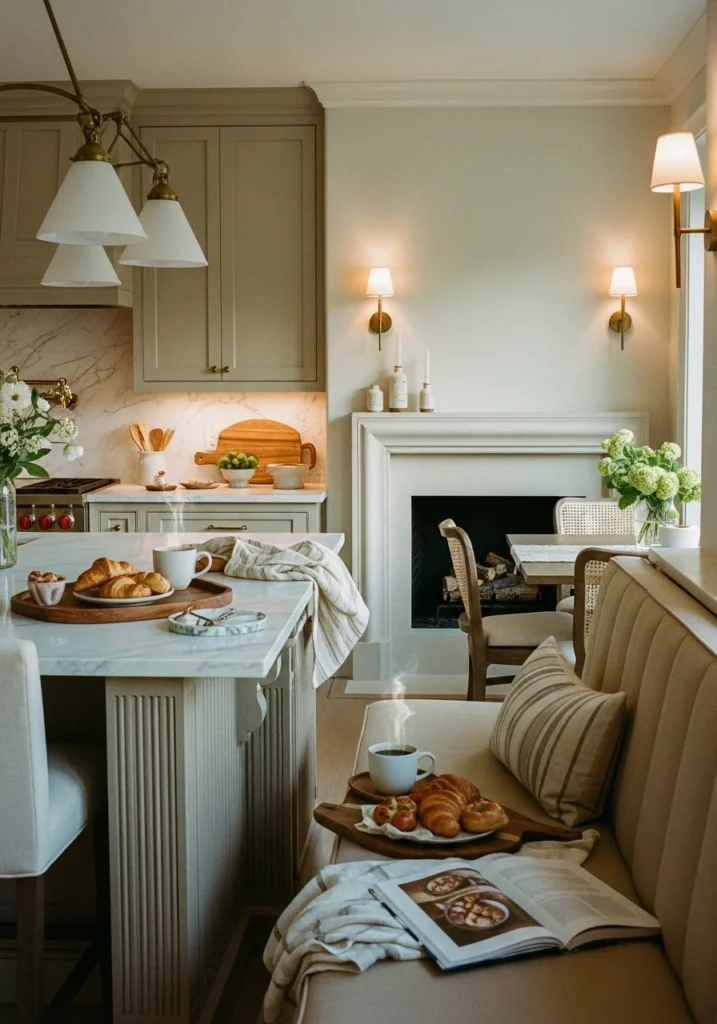
Design kitchens that open to fireplace eating nooks with cream plaster hearths and built-in banquettes in warm oatmeal fabrics. Use sand-colored cabinets with light marble counters while fluted island ends provide additional seating.
Stage with coffee service, fresh pastries on wooden boards, and open cookbooks. Soft wall sconces near fireplaces and pendants above islands create golden-hour ambiance for evening gatherings.
11. Add Sophisticated Details Through Fluted Cabinetry
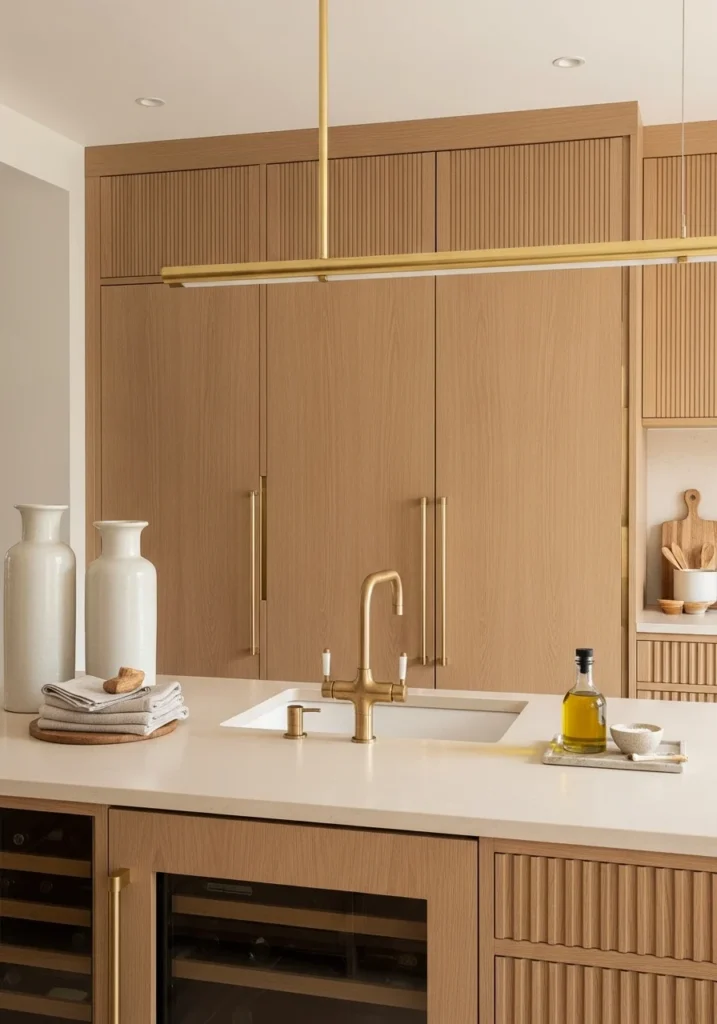
Feature fluted oak cabinet fronts in soft honey tones with slim brass trim accents paired with warm quartz countertops. Include integrated undercounter refrigeration and shallow trough sinks with sculptural brass spouts.
Style with tall ceramic vases, folded linen towels, and olive oil service trays. Suspended brass linear fixtures and recessed mood lighting provide both task and ambient illumination.
12. Maximize Natural Light With Skylights and Concrete
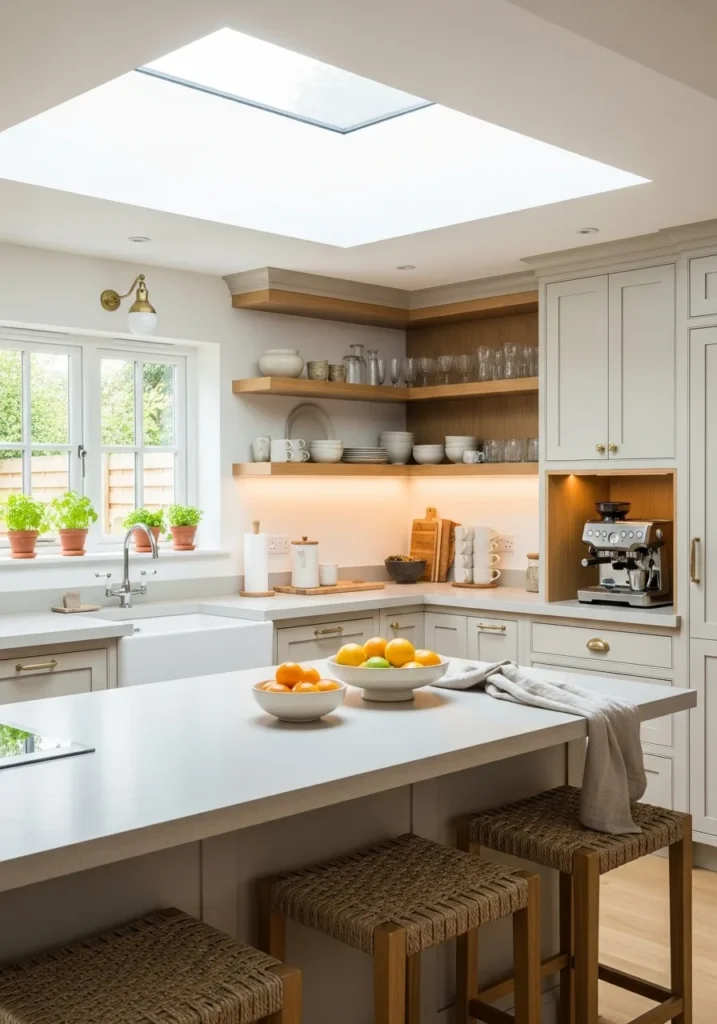
Use soft beige cabinets with polished light concrete countertops under central skylights that flood spaces with natural light. Include warm oak open shelving with inset espresso stations and woven island stools.
Style with potted herbs on windowsills, ceramic bowls of citrus, and folded linen runners. Complement natural light with warm under-cabinet LED strips for evening functionality.
13. Design Intimate Dining With Curved Banquettes
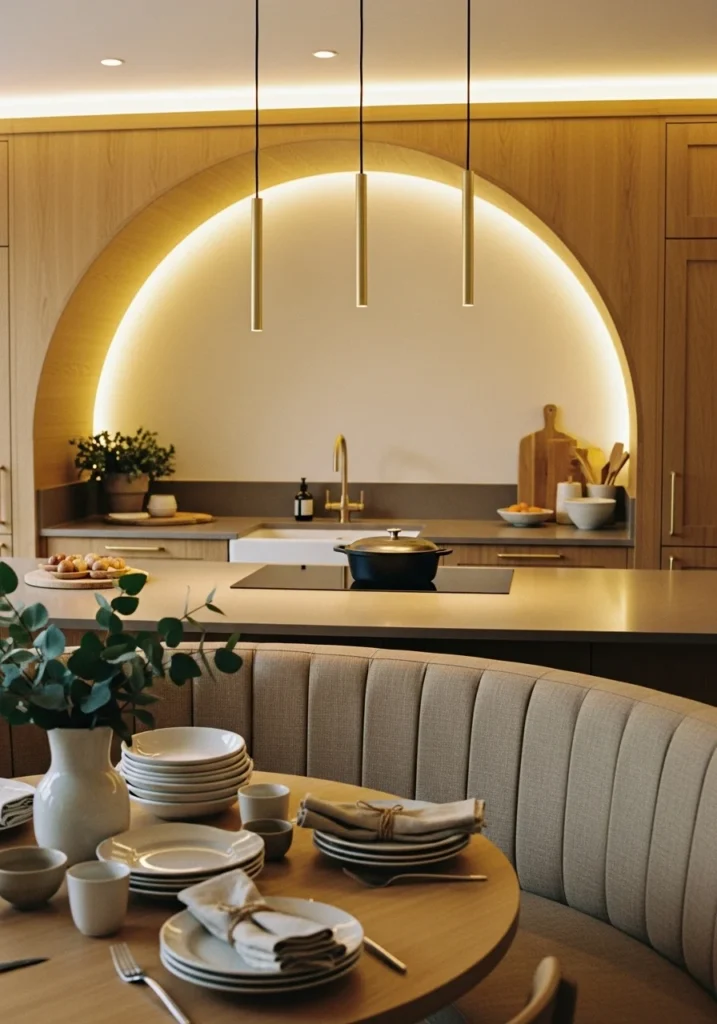
Create kitchen-dining hybrids with curved built-in banquettes in warm linen tucked into arced oak-paneled alcoves. Use linear islands in soft mocha quartz with slim brass pendants providing focused lighting.
Style with stacked ceramic plates, linen napkins, eucalyptus arrangements, and slow-cooking vessels. Intimate pendant lighting and soft ambient cove lighting create restaurant-quality atmosphere.
14. Create Display Galleries Through Open Shelving
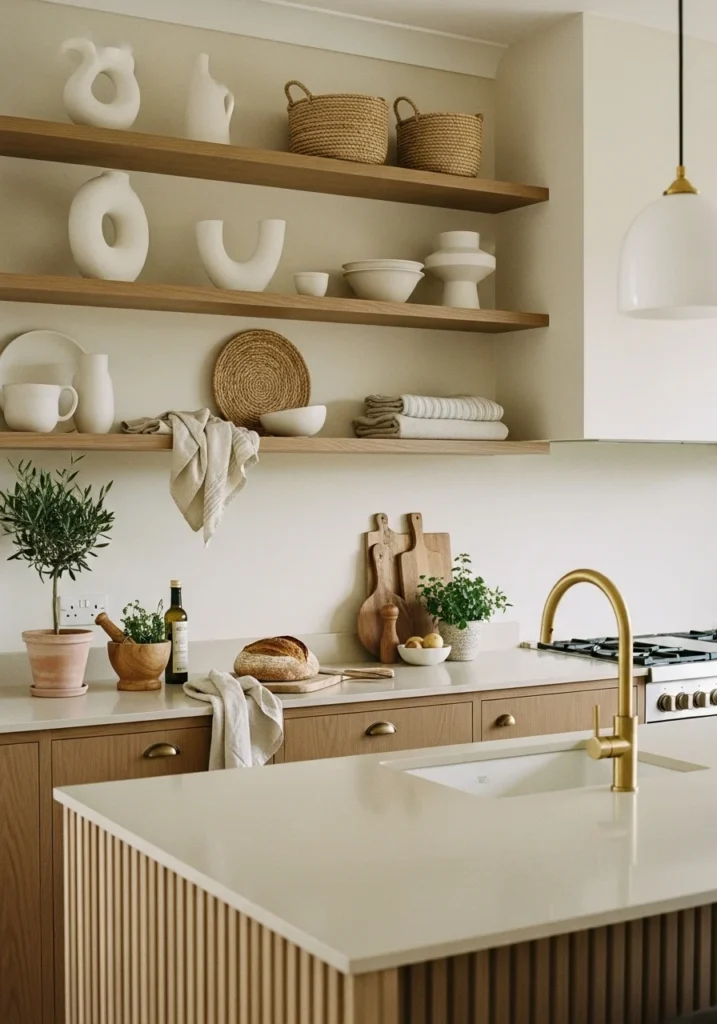
Design deep open timber shelves displaying sculptural white ceramics, linen textiles, and woven baskets against warm cream plaster walls. Use warm beige quartz countertops with fluted island ends and brass faucets over ceramic basin sinks.
Style with fresh sourdough, olive oil bottles, wooden mortars with herbs, and small potted olive trees. Early morning natural light combined with warm pendants creates cinematic, editorial-quality illumination.
Making Neutrals Feel Luxurious Rather Than Basic
The difference between sophisticated warm neutral kitchens and boring beige ones usually comes down to quality materials and thoughtful layering. Invest in genuine materials like real stone, actual wood, and quality hardware rather than trying to achieve the look through paint colors alone.
Pay attention to undertones throughout your space. All your neutrals should have similar warm undertones so everything feels harmonious rather than accidentally assembled from different color families.
Avoiding the Beige Trap
Warm neutrals don’t mean everything has to be the same shade. Layer different neutral tones—cream, oatmeal, soft taupe, warm gray—to create depth and visual interest within your palette.
Include enough textural variety to prevent flatness. Mix smooth surfaces like marble with rough textures like reclaimed wood, soft fabrics, and woven elements to create richness that paint alone cannot achieve.
Lighting Makes All the Difference
Warm neutral kitchens live and die by their lighting. Use warm-temperature bulbs (2700K) throughout and layer different types of lighting—ambient, task, and accent—to create depth and functionality.
Natural light is crucial too. Maximize whatever natural light you have through strategic window treatments and mirror placement, but ensure your artificial lighting can create the same warm atmosphere after dark.
Final Thoughts
Creating a warm neutral kitchen that feels luxurious rather than basic requires understanding that neutral doesn’t mean boring or monochromatic. The best warm neutral kitchens use quality materials, thoughtful lighting, and careful attention to texture to create spaces that feel both sophisticated and genuinely welcoming.
When your kitchen starts feeling like a place where you actually want to spend time cooking and gathering—somewhere that feels both beautiful and completely functional—you’ll know you’ve successfully created that perfect balance of warmth and sophistication that makes neutral kitchens so appealing.

